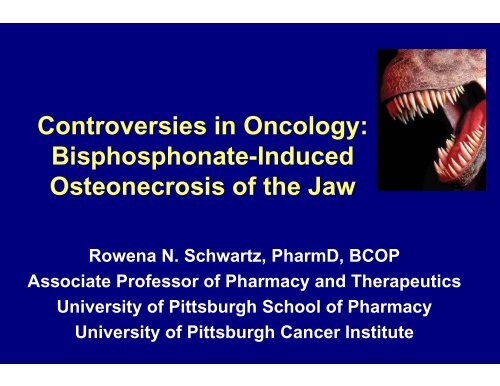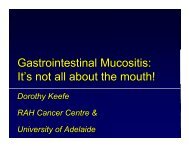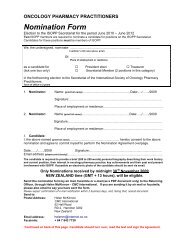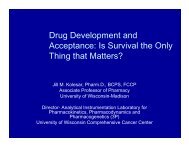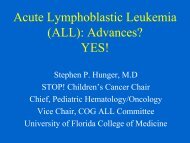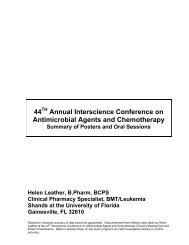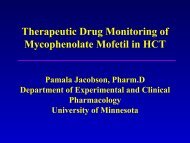Bisphosphonate-Induced Osteonecrosis of the Jaw - International ...
Bisphosphonate-Induced Osteonecrosis of the Jaw - International ...
Bisphosphonate-Induced Osteonecrosis of the Jaw - International ...
You also want an ePaper? Increase the reach of your titles
YUMPU automatically turns print PDFs into web optimized ePapers that Google loves.
Controversies in Oncology:<br />
<strong>Bisphosphonate</strong>-<strong>Induced</strong><br />
<strong>Osteonecrosis</strong> <strong>of</strong> <strong>the</strong> <strong>Jaw</strong><br />
Rowena N. Schwartz, PharmD, BCOP<br />
Associate Pr<strong>of</strong>essor <strong>of</strong> Pharmacy and Therapeutics<br />
University <strong>of</strong> Pittsburgh School <strong>of</strong> Pharmacy<br />
University <strong>of</strong> Pittsburgh Cancer Institute
<strong>Bisphosphonate</strong>-<strong>Induced</strong><br />
<strong>Osteonecrosis</strong> <strong>of</strong> <strong>the</strong> <strong>Jaw</strong><br />
<strong>Bisphosphonate</strong>s:<br />
• syn<strong>the</strong>tic analogs <strong>of</strong> naturally occurring<br />
pyrophosphonate<br />
• accumulate to sites <strong>of</strong> active bone formation<br />
• more potent bisphosphonates have been<br />
incorporated into clinical practice<br />
• increasing number <strong>of</strong> reports in <strong>the</strong> oncology<br />
and dental literature <strong>of</strong> avascular osteonecrosis<br />
<strong>of</strong> <strong>the</strong> jaw
<strong>Bisphosphonate</strong>-<strong>Induced</strong><br />
<strong>Osteonecrosis</strong> <strong>of</strong> <strong>the</strong> <strong>Jaw</strong><br />
<strong>Bisphosphonate</strong>s:<br />
• induce osteoclasts to self destruct<br />
• associated with osteoporosis when <strong>the</strong>y carve<br />
out bone cavities causing excessive loss <strong>of</strong><br />
calcium ⇒ decrease rate <strong>of</strong> bone resorption and<br />
indirect increase in bone mineral density
<strong>Bisphosphonate</strong>-<strong>Induced</strong><br />
<strong>Osteonecrosis</strong> <strong>of</strong> <strong>the</strong> <strong>Jaw</strong><br />
Reports <strong>of</strong> <strong>Osteonecrosis</strong> <strong>of</strong> <strong>the</strong> <strong>Jaw</strong>:<br />
• case report <strong>of</strong> osteonecrosis <strong>of</strong> <strong>the</strong> maxillas as a<br />
complication <strong>of</strong> chemo<strong>the</strong>rapy<br />
Sung EC, et al. Spec Care Dentist 2002:142<br />
• case reports (n = 3) <strong>of</strong> osteonecrosis <strong>of</strong> <strong>the</strong> jaw among<br />
patients with metastatic breast cancer undergoing<br />
treatment with chemo<strong>the</strong>rapy and steroids ⇒ later<br />
reported that patients were receiving pamidronate<br />
Wang J, et al. J Oral Maxill<strong>of</strong>ac Surg 2003: 1104<br />
Pogrel MA. J Oral Maxill<strong>of</strong>ac Surg 2004: 391
<strong>Bisphosphonate</strong>-<strong>Induced</strong><br />
<strong>Osteonecrosis</strong> <strong>of</strong> <strong>the</strong> <strong>Jaw</strong><br />
Reports <strong>of</strong> <strong>Osteonecrosis</strong> <strong>of</strong> <strong>the</strong> <strong>Jaw</strong>:<br />
• case reports (n = 36) <strong>of</strong> painful bone exposure<br />
in cancer patients treated with<br />
bisphosphonates.<br />
• multiple myeloma and breast cancer<br />
• pamidronate or zolendronic acid or both<br />
• many <strong>of</strong> <strong>the</strong> cases <strong>of</strong> ONJ were initiated by<br />
surgery to remove teeth<br />
Marx RE. J Oral Maxill<strong>of</strong>ac Surg 2003:1115
<strong>Bisphosphonate</strong>-<strong>Induced</strong> <strong>Osteonecrosis</strong>:<br />
Necrosis <strong>of</strong> Maxilla<br />
Carter G, et al. MJA 2005
<strong>Bisphosphonate</strong>-<strong>Induced</strong> <strong>Osteonecrosis</strong>:<br />
Necrosis <strong>of</strong> Maxilla<br />
Carter G, et al. MJA 2005
<strong>Bisphosphonate</strong>-<strong>Induced</strong><br />
<strong>Osteonecrosis</strong> <strong>of</strong> <strong>the</strong> <strong>Jaw</strong><br />
• Clinical characteristics:<br />
• non-healing extraction socket or exposed jaw<br />
bone with progression to sequestration with<br />
purulent discharge<br />
• trauma induced by prosthodontic appliances<br />
• secondary infection<br />
• peripheral nerve compression<br />
• Radiologic characteristics: similar to infected<br />
osteoradionecrosis (IORN)
<strong>Bisphosphonate</strong>-<strong>Induced</strong><br />
<strong>Osteonecrosis</strong> <strong>of</strong> <strong>the</strong> <strong>Jaw</strong><br />
• Histologic Comparison:<br />
• 8 cases <strong>of</strong> BON <strong>of</strong> <strong>the</strong> jaw<br />
• 10 cases with infected osteoradionecrosis (IORN)<br />
• Results:<br />
• Non vital bone tissue in all cases<br />
• gross pattern <strong>of</strong> necrosis differed between IORN and<br />
BON<br />
• inflammatory infiltrates in all cases<br />
• fibrosis <strong>of</strong> medullary spaces in most cases<br />
• increase cellularity in <strong>the</strong> intima and media <strong>of</strong> <strong>the</strong><br />
artery in BON vs. hyalinization in IORN<br />
• actinomyces colonies found in all cases<br />
• osteoclasts detected in tissue specimen<br />
Hansen et al. J Oral Pathol Med 2006
<strong>Bisphosphonate</strong>-<strong>Induced</strong><br />
<strong>Osteonecrosis</strong> <strong>of</strong> <strong>the</strong> <strong>Jaw</strong><br />
• Histologic Comparison:<br />
• 8 cases <strong>of</strong> BON <strong>of</strong> <strong>the</strong> jaw<br />
• 10 cases with infected osteoradionecrosis (IORN)<br />
• Results:<br />
• BON<br />
- ⇑ multifocality (maxilla and mandible)<br />
- areas <strong>of</strong> osteonecrosis patchier<br />
• IORN<br />
- area <strong>of</strong> necrosis is typically larger<br />
• BON and IORN<br />
- Actinomyces colonies in close contact to necrotic<br />
bone<br />
Hansen et al. J Oral Pathol Med 2006
<strong>Bisphosphonate</strong>-<strong>Induced</strong><br />
<strong>Osteonecrosis</strong> <strong>of</strong> <strong>the</strong> <strong>Jaw</strong><br />
• Histologic Comparison:<br />
• 8 cases <strong>of</strong> BON <strong>of</strong> <strong>the</strong> jaw<br />
• 10 cases with infected osteoradionecrosis<br />
(IORN)<br />
• Results:<br />
• BON and IORN<br />
- Actinomyces colonies in close contact to<br />
necrotic bone ⇒ ? organism involved in<br />
non-healing inflammatory process<br />
Hansen et al. J Oral Pathol Med 2006
<strong>Bisphosphonate</strong>-<strong>Induced</strong><br />
<strong>Osteonecrosis</strong> <strong>of</strong> <strong>the</strong> <strong>Jaw</strong><br />
Proposed Pathologic Mechanism:<br />
• inhibition <strong>of</strong> osteoclastic function<br />
• inhibition <strong>of</strong> osteoblastic-mediated osteoclastic<br />
resorption<br />
• antiangiogenic effects (NBPs)<br />
• suppression <strong>of</strong> bone turnover and physiologic<br />
remodeling<br />
• stress <strong>of</strong> normal jaw use ⇒ microdamage and<br />
micr<strong>of</strong>ractures not repaired<br />
• chronic non-healing inflammation
Proposed Pathobiological Model for<br />
<strong>Bisphosphonate</strong>-Associated <strong>Osteonecrosis</strong> (BON)<br />
<strong>Bisphosphonate</strong>s<br />
+<br />
Infection and<br />
trauma<br />
<strong>Bisphosphonate</strong><br />
Bone Resorption<br />
<strong>Bisphosphonate</strong>s<br />
And<br />
Chemo<strong>the</strong>rapy<br />
Activation <strong>of</strong> Basic Multicellular Unit<br />
Bone Cellularity and Blood Flow<br />
Cell Necrosis and Apoptosis<br />
Dental Extraction<br />
Trauma<br />
Infection<br />
Bone Manipulation<br />
igliorati CA, et al. Cancer 2005<br />
BON
<strong>Bisphosphonate</strong>-<strong>Induced</strong><br />
<strong>Osteonecrosis</strong> <strong>of</strong> <strong>the</strong> <strong>Jaw</strong><br />
<strong>Bisphosphonate</strong> Associated Risk Factors:<br />
• Which bisphosphonates?<br />
• Dose effect?<br />
• Duration effect?<br />
• Route <strong>of</strong> administration?
<strong>Bisphosphonate</strong>s: Antiresorptive Potency<br />
Structure<br />
agent<br />
Short Alkyl or Halide Side Chain<br />
etidronate<br />
Cyclic chloro side chain<br />
tiludronate<br />
Aminoterminal group<br />
pamidronate<br />
alendronate<br />
Cyclic Nitrogen-Containing side<br />
chain<br />
risedronate<br />
ibandronate<br />
zolendronic acid<br />
Antiresorptive<br />
Relative Potency<br />
1<br />
10<br />
100<br />
100 - 1000<br />
1000 – 10000<br />
1000 – 10000<br />
> 10000<br />
Route <strong>of</strong><br />
Administration<br />
IV and oral<br />
oral<br />
IV<br />
oral<br />
oral<br />
IV and oral<br />
IV
<strong>Bisphosphonate</strong>-<strong>Induced</strong><br />
<strong>Osteonecrosis</strong> <strong>of</strong> <strong>the</strong> <strong>Jaw</strong><br />
Potential Patient Associated Risk Factors:<br />
• Cancer<br />
• overall tumor burden<br />
• stage <strong>of</strong> disease<br />
• extent <strong>of</strong> skeletal involvement<br />
• Comorbidities<br />
• diabetes mellitus<br />
• immunocompetency<br />
• oral health<br />
• Concurrent medication<br />
• immunosuppression<br />
• anti-angiogenic agents (e.g. lenolidamide, thalidomide)
<strong>Bisphosphonate</strong>-<strong>Induced</strong><br />
<strong>Osteonecrosis</strong> <strong>of</strong> <strong>the</strong> <strong>Jaw</strong><br />
Estimating <strong>the</strong> incidence <strong>of</strong> OJN:<br />
• Estimated incidence <strong>of</strong> 4.6% in one series <strong>of</strong> cancer<br />
patients receiving bisphosphonates.<br />
Maerevoet M, et al. NEJM 2005:100<br />
• Survey by <strong>the</strong> <strong>International</strong> Myeloma Foundation<br />
designed to asses <strong>the</strong> risk factors for OJN:<br />
10% risk <strong>of</strong> OJN in patients receiving zolendronic acid<br />
4.6% risk <strong>of</strong> OJN in patients receiving pamidronate<br />
Durie BG, et al. NEJM 2005:99
<strong>Bisphosphonate</strong>-Associated <strong>Osteonecrosis</strong><br />
American Academy <strong>of</strong> Oral Medicine Position Paper<br />
• Position paper that addresses:<br />
• prevention <strong>of</strong> bisphosphonate-associated<br />
osteonecrosis (BON)<br />
• recommendation for management <strong>of</strong> BON<br />
• “Recommendations are based on expert opinion<br />
as <strong>the</strong>re are not available randomized controlled<br />
trials that support any effect on patient<br />
management and outcomes.”<br />
Migliorati CA, et al. JADA 2005:1658
<strong>Bisphosphonate</strong>-Associated <strong>Osteonecrosis</strong><br />
American Academy <strong>of</strong> Oral Medicine Position Paper<br />
• “Recommendations are based on expert opinion<br />
as <strong>the</strong>re are not available randomized controlled<br />
trials that support any effect on patient<br />
management and outcomes.”<br />
• treatment is prevention<br />
Migliorati CA, et al. JADA 2005:1658
Risk Factors Associated with <strong>Bisphosphonate</strong>-<br />
Associated <strong>Osteonecrosis</strong><br />
• IV use <strong>of</strong> bisphosphonates such as pamidronate<br />
and zoledronic acid<br />
• multiple myeloma<br />
• metastatic cancer to <strong>the</strong> bone associated with<br />
breast cancer, prostate cancer and lung cancer<br />
• dental extractions<br />
• surgical bone manipulations<br />
• trauma from dentures<br />
• presence <strong>of</strong> oral infection<br />
• poor oral health<br />
Migliorati CA, et al. JADA 2005:1658
Risk Factors Associated with <strong>Bisphosphonate</strong>-<br />
Associated <strong>Osteonecrosis</strong><br />
Management considerations:<br />
• Dental examination for patient prior to<br />
initiation <strong>of</strong> bisphosphonate <strong>the</strong>rapy<br />
- assessment <strong>of</strong> risk<br />
- procedures prior to <strong>the</strong>rapy (e.g.<br />
extraction, restorative dentistry )<br />
- management <strong>of</strong> potential sites <strong>of</strong> infection<br />
- education for oral hygiene<br />
Migliorati CA, et al. JADA 2005:1658
Risk Factors Associated with <strong>Bisphosphonate</strong>-<br />
Associated <strong>Osteonecrosis</strong><br />
Management considerations:<br />
• Routine dental treatment for patients receiving<br />
bisphosphonates:<br />
“ There are no prospective scientific studies to<br />
support specific recommendations regarding<br />
whe<strong>the</strong>r providing dental treatment for patients<br />
taking bisphosphonate places <strong>the</strong> patient at any<br />
risk <strong>of</strong> developing BON.”<br />
Migliorati CA, et al. JADA 2005:1658
Risk Factors Associated with <strong>Bisphosphonate</strong>-<br />
Associated <strong>Osteonecrosis</strong><br />
Management considerations:<br />
• Management <strong>of</strong> dental care for patient with BON:<br />
- Minimization <strong>of</strong> trauma<br />
- Avoid dental extractions (close follow up)<br />
- Endodontic procedures if needed<br />
- Surgical removal <strong>of</strong> bone<br />
- S<strong>of</strong>t vinyl appliances to cover necrotic bone<br />
- Infections ⇒ antibiotics<br />
Migliorati CA, et al. JADA 2005:1658


